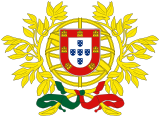
Back Verfassung Portugals German Σύνταγμα της Πορτογαλίας Greek Konstitucio de Portugalio Esperanto Constitución portuguesa de 1976 Spanish قانون اساسی پرتغال Persian Portugalin perustuslaki Finnish Constitution portugaise de 1976 French Constitución portuguesa de 1976 Galician חוקת פורטוגל HE Costituzione del Portogallo del 1976 Italian
This article needs additional citations for verification. (December 2015) |
| Constitution of the Portuguese Republic | |
|---|---|
 | |
| Overview | |
| Jurisdiction | Portugal |
| Ratified | 2 April 1976 |
| Date effective | 25 April 1976 |
| System | Semi-presidential republic |
| Government structure | |
| Branches | 4 |
| Head of state | President with significant reserve powers |
| Chambers | Unicameral (Assembly of the Republic) |
| Executive | Government, headed by a Prime Minister |
| Judiciary | Constitutional Court, Supreme Court of Justice and lower general courts, Supreme Administrative Court and lower administrative courts and Court of Auditors |
| Federalism | Unitary state, but the outermost archipelagoes enjoy self-government |
| Electoral college | No |
| Entrenchments | 15 (14 material ones and a circumstantial one) |
| History | |
| First legislature | 3 June 1976 |
| First executive | 23 July 1976 |
| Amendments | 7 |
| Last amended | 2005 |
| Author(s) | Constituent Assembly of Portugal |
| Signatories | Henrique de Barros and Francisco da Costa Gomes |
| Supersedes | Portuguese Constitution of 1933 |
| Full text | |
 |
|---|
| Constitution |
The present Constitution of Portugal was adopted in 1976 after the Carnation Revolution.[1] It was preceded by a number of constitutions including the first one created in 1822 (following the Liberal Revolution of 1820),[2] 1826 (drawn up by King Dom Pedro IV),[3] 1838 (after the Liberal Wars),[4] 1911 (following the 5 October 1910 revolution),[5] and 1933 (after the 28 May 1926 coup d'état).[6]
- ^ "The Constitution of 1976 and subsequent revisions". The Constitutional Monarchy. Assembly of the Republic of Portugal. Archived from the original on 22 October 2013. Retrieved 12 December 2013.
- ^ "The Cortes in the Constitution of 1822". The Constitutional Monarchy. Assembly of the Republic of Portugal. Archived from the original on 22 October 2013. Retrieved 12 December 2013.
- ^ "The Courts General in the Constitutional Charter of 1826". The Constitutional Monarchy. Assembly of the Republic of Portugal. Archived from the original on 22 October 2013. Retrieved 12 December 2013.
- ^ "The Courts General in the Constitution of 1838". The Constitutional Monarchy. Assembly of the Republic of Portugal. Archived from the original on 22 October 2013. Retrieved 12 December 2013.
- ^ "The Congress of the Republic in the Constitution of 1911". The Constitutional Monarchy. Assembly of the Republic of Portugal. Archived from the original on 22 October 2013. Retrieved 12 December 2013.
- ^ "The National Assembly in the Constitution of 1933". The Constitutional Monarchy. Assembly of the Republic of Portugal. Archived from the original on 22 October 2013. Retrieved 12 December 2013.